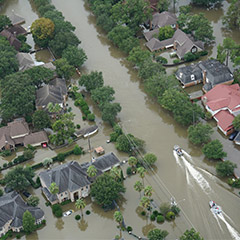Employers Affected by Recent Hurricanes Get a Valuable Tax Credit
October 23, 2017 | IRS Regulation, Tax Planning, Tax Preparation
 On September 29, 2017, a new law was signed by President Trump providing various tax breaks for victims of Hurricanes Harvey, Irma and Maria. Among them is a valuable tax credit for eligible employers affected by the devastating hurricanes.
On September 29, 2017, a new law was signed by President Trump providing various tax breaks for victims of Hurricanes Harvey, Irma and Maria. Among them is a valuable tax credit for eligible employers affected by the devastating hurricanes.
An “employee retention credit” is allowed by the Disaster Tax Relief and Airport and Airway Extension Act of 2017. In general, the credit equals 40% of up to $6,000 of qualified wages with respect to each eligible employee for the tax year. Here are the specifics of the law, after first covering some background information.
Before the new law: For purposes of determining each credit’s allowance limitation for the tax year, certain business incentive credits are combined into one general business credit. Claimed on Form 3800, the credit is allowed against income tax for a particular tax year and equals the sum of:
- The business credit carryforwards carried to the tax year,
- The current year general business credit, and
- The business credit carrybacks carried to the tax year.
New law: A new employee retention credit is now available for “eligible employers” affected by Hurricanes Harvey, Irma and Maria. Eligible employers are generally defined as those that:
- Conducted an active trade or business in a disaster zone as of a specified date (for Hurricane Harvey, August 23, 2017; for Irma, September 4, 2017 and for Maria, September 16, 2017), and
- The active trade or business was, on any day between the specified date and January 1, 2018, rendered inoperable as a result of damage sustained by the hurricane.
The credit generally equals 40% of up to $6,000 of “qualified wages” with respect to each “eligible employee” of such employer for the tax year. Therefore, the maximum credit per employee is $2,400 ($6,000 times 40%).
Here’s a simplified example: You’re an eligible employer in the Hurricane Harvey, Irma or Maria disaster zones. You have two eligible employees that you pay qualified wages of $4,000 and $7,000 respectively. You’re entitled to a total credit of $4,000; $1,600 for the wages paid to the first employee ($4,000 times 40%) and $2,400 for $6,000 of the wages paid to the second employee ($6,000 times 40%).
What defines an eligible employee? An eligible employee with respect to an eligible employer is one whose principal place of employment with the employer was in a disaster zone as of the respective date above during Hurricane Harvey, Irma, or Maria.
Qualified wages mean wages paid or incurred by an eligible employer with respect to an eligible employee on any day after the specified date (above) and before January 1, 2018, which occurs during the period:
- Beginning on the date on which the employer’s trade or business first became inoperable at the principal place of employment of the employee immediately before the respective hurricane, and
- Ending on the date on which the trade or business resumed significant operations at the principal place of employment.
Qualified wages include wages paid without regard to whether the employee performs services, performs services at a different place of employment than such principal place of employment, or performs services at such principal place of employment before significant operations have resumed.
There are Limitations
For purposes of the employee retention tax credit, an employee can’t be taken into account more than one time. For example, if an employee is an eligible employee of an employer with respect to Hurricane Harvey for purposes of the credit, the employee can’t also be an eligible employee of the employer with respect to Hurricane Irma or Hurricane Maria.
Ask your tax advisor for more details about this important credit and how your business might be able to benefit, especially because the new law also contains other rules.
